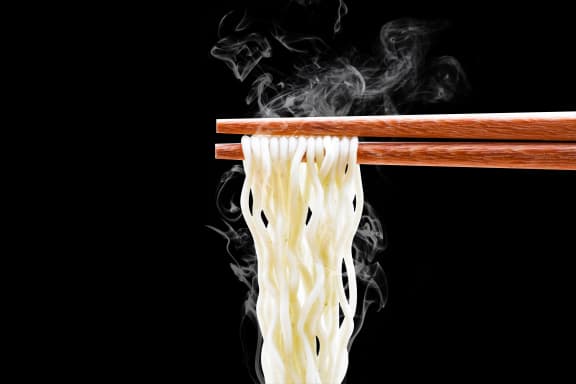Making seafood ramen at home doesn’t have to be a time-consuming endeavor, even if you’re making your own stock from scratch. When you want a delicious bowl of ramen at home that takes you beyond instant ramen expectations, wild-caught seafood from Alaska is your shortcut to high flavor in no time.
Here are 4 quick and flavorful ideas that will turn a humble bowl of comfort food into a fine feast, any time you fancy seafood ramen at home:
Add Texture with Salmon Skin
Think about the ways that seafood can add texture to your bowl of ramen. Wild salmon, in particular, has lots of texture potential.
A crispy-seared salmon fillet, served skin-side up on a steaming bowl of broth, is one approach to this. Our sockeye and coho Captain’s Cuts are tail end portions with a higher skin-to-meat ratio, which makes them a really good option for something like ramen. The Starving Chef builds a bowl of ramen out of the same pan that was used to sear the salmon, which is an ingenious way to build flavor, as you have the opportunity to deglaze the pan with stock.
Alternatively, you can take Eat, Drink, Films cue and whip up a batch of salmon skin crisps to garnish your meal, or coat the salmon in a furikake crust.
Integrate Seafood Stock Into Your Ramen Broth
Good ramen is all about the broth, and swapping in some seafood stock is a quick way to add lots of flavor to your ramen. After all, whether you’re making fish stock or prawn stock, a seafood-based stock takes a fraction of the time it takes to make a pork or chicken stock.
When making seafood ramen, an easy way to layer in more complexity is by using a seafood stock. Food52’s recipe for ramen calls for a homemade fish stock as the base of its scallop-shrimp-crab ramen. If you have some in your kitchen, great!
Otherwise you can quickly transform spot prawn shells into a prawn stock that you can use instead — or throw a little of everything into a pot, including last night’s crab shells — to make seafood stock for your ramen. Whatever you make is going to be full of flavor, and will be much lighter than a heavy pork-based broth. However, if you want to add some richness, try finishing the ramen with a pad of butter, just like Brainwash Media did for their bowl of wild shrimp ramen.
Go Brothless, Without Sacrificing Flavor
To speed up the ramen-making process, nix the broth and embrace the sauce.
Serious Eats has a recipe for mazeman with XO sauce, fusing the cuisines of Japan and Hong Kong, that you could top with any variety of wild-caught Alaskan seafood you like. Scallops or spot prawns would be a natural choice, as they’ll reflect some of the ingredients used to make XO sauce, but salmon or even a white variety of fish like pollock quick cuts could be a great protein option; broiled or grilled fish adds a hint of char that always goes well with ramen.
Sablefish, too, is an excellent choice of seafood to feature on a bowl of brothless ramen. The fillet itself is buttery and silky, adding richness to the noodles; when glazed in a ginger-honey-soy sauce as it’s done in this recipe from Anchorage Daily News, you won’t miss the broth at all.
Have Ramen for Brunch
You might think of ramen as a late-night meal, but why not flip your day around and have ramen for brunch?
Shutterbean uses flaked hot smoked salmon to add easy protein to a bowl of ramen made with chicken stock enhanced with a half packet of ramen seasoning. And, of course, there’s an egg in the mix, too — a pretty standard addition to ramen that takes on a brunchy look when paired up with smoked salmon.
Even a bowl of instant ramen can benefit from the addition of smoked salmon. Rachael Ray Magazine suggests topping a saucy bowl of instant ramen (again, made with half a seasoning packet) with a few ribbons of cold smoked salmon, pickled ginger, and scallions, giving it a sort of sushi roll-inspired flavor combo.






